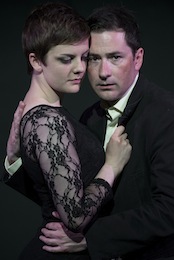Watching Closer today, it is easy to see why Patrick Marber’s 1997 play became a Broadway hit, later adapted to the synonymous movie featuring some of Hollywood’s A-list. A dark, domestic comedy, it offers snippets from several years within the lives of two couples (Alice and Dan, Larry and Anna) who cheat, lie and switch partners. The play is made both entertaining and filmic through its plot twists and reversals, as well as split screen and merged scenes. It was, at the time of writing, a work of immediate relevance: set in London of the 90s, where it premiered; offering strikingly realist, contemporary dialogue; and focusing on identity, intimacy and truth in the face of proliferating new media designed to bring us ‘closer’ together. Staged recently at the Town Hall’s studio theatre, Anam Theatre’s production brought its audience closer still to the play’s engaging issues and biting wit.
Peter Shine’s adaptable set pieces served to intensify the production’s intimacy. Two large white panels, for example, were regularly positioned slanting out towards the viewers, condensing the performance space and pushing the action nearer to the audience. These functioned variously to suggest the couples’ separate dwellings during split screen scenes (with each panel aptly spot-lit by Matt Burke) and to convey the minimalist interior design of urban spaces—including Anna’s photography studio, the art gallery and the aquarium. The set was a little less stripped back than the text requires, with locations such as Larry and Anna’s living room becoming more detailed and homely, but overall Shine’s design remained effectively suggestive rather than representational. Attached to each white panel, a photograph brought us to the art gallery, while a framed document took us back to Postman’s Park.
 Scenes were punctuated by recorded musical interludes, functional in providing fillers during darkened set changes but chosen carefully to blend with the opening moments of new scenes. Matt Burke’s lighting, Sarah O’Toole’s sound design and Sinéad Coughlan’s costumes also served to suggest time and place. The choices of music and clothing were period-appropriate, evocative and, at times, appropriately provocative. Some of Coughlan’s selections for Alice, for example, contributed to Róisín Eyres’ virtuoso performance of the femme fatale and former stripper. Under O’Toole’s direction, Eyres played with gendered assumptions by celebrating the performative female body as powerful armour against manipulation—particularly during the scene in which Alice, having returned to her former profession, dances for Larry at the strip-club. Through confident, creative gesture, movement and delivery, Eyres' Alice challenged Cormac Culkeen’s would-be Machiavellian Larry. Burke’s elegant chiaroscuro lighting fitted with the scene’s blend of conflict, seduction and subversion.
Scenes were punctuated by recorded musical interludes, functional in providing fillers during darkened set changes but chosen carefully to blend with the opening moments of new scenes. Matt Burke’s lighting, Sarah O’Toole’s sound design and Sinéad Coughlan’s costumes also served to suggest time and place. The choices of music and clothing were period-appropriate, evocative and, at times, appropriately provocative. Some of Coughlan’s selections for Alice, for example, contributed to Róisín Eyres’ virtuoso performance of the femme fatale and former stripper. Under O’Toole’s direction, Eyres played with gendered assumptions by celebrating the performative female body as powerful armour against manipulation—particularly during the scene in which Alice, having returned to her former profession, dances for Larry at the strip-club. Through confident, creative gesture, movement and delivery, Eyres' Alice challenged Cormac Culkeen’s would-be Machiavellian Larry. Burke’s elegant chiaroscuro lighting fitted with the scene’s blend of conflict, seduction and subversion.
By tightly regulating the production’s pace and energy, O’Toole’s direction skillfully negotiated the play’s emotional peaks and troughs, offering moments of striking intensity balanced by well-timed humour. Passionate outbursts, including Alice and Anna’s confrontations, and Alice’s final row with Dan (which became quite heated and physical) were very gripping, while scenes such as Dan’s online seduction of Larry (in which Dan pretends to be Anna) gained copious laughs from the audience.
As Dan, Martin Maguire offered many hilarious moments. Yet, while Maguire is a great comedy actor (evident also in his performance as George in Caroline Lynch’s Almost a Fantasy), here he had the opportunity to show his range—particularly in the final conflict between Dan and Alice. Grace Kiely successfully inhabited Anna’s reserved charm, but scenes depicting Anna’s relationship with one of her suitors occasionally lacked chemistry. Culkeen was an apt choice as the boorish Larry. However, crude make-up and the actor’s effort to keep up a working-class British accent distracted from an otherwise effective performance. That said, with Maguire, Culkeen and Kiely deftly handled the play’s merging of instances from Anna’s meeting with Larry to sign divorce papers with moments from her return to Dan having slept with Larry.
Together, the creative team fashioned a stifling world of condensed time and space, in which characters fail at love, having sacrificed personal truths in favour of fleeting, fabricated visions of desire—traded here like commodities. Anam approached the play as a period piece, but the production revealed its enduring relevance. The company capitalised on the play’s potential to ask who we are and who we might become in an age increasingly saturated by fragmented information, image-obsession and media personae.
Siobhán O’Gorman lectures on early modern, modern and contemporary theatre at the National University of Ireland, Galway.